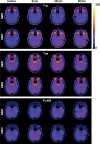The effects of normobaric and hyperbaric oxygenation on MRI signal intensities in T1 -weighted, T2 -weighted and FLAIR images in human brain
- PMID: 37665738
- PMCID: PMC10476901
- DOI: 10.2478/raon-2023-0043
The effects of normobaric and hyperbaric oxygenation on MRI signal intensities in T1 -weighted, T2 -weighted and FLAIR images in human brain
Abstract
Background: Dissolved oxygen has known paramagnetic effects in magnetic resonance imaging (MRI). The aim of this study was to compare the effects of normobaric oxygenation (NBO) and hyperbaric oxygenation (HBO) on human brain MRI signal intensities.
Patients and methods: Baseline brain MRI was performed in 17 healthy subjects (mean age 27.8 ± 3.2). MRI was repeated after exposure to the NBO and HBO at different time points (0 min, 25 min, 50 min). Signal intensities in T 1-weighted, T 2-weighted images and fluid attenuated inversion recovery (FLAIR) signal intensities of several intracranial structures were compared between NBO and HBO.
Results: Increased T 1-weighted signal intensities were observed in white and deep grey brain matter, cerebrospinal fluid (CSF), venous blood and vitreous body after exposure to NBO as well as to HBO compared to baseline (Dunnett's test, p < 0.05) without significant differences between both protocols. There was also no significant difference in T 2-weighted signal intensities between NBO and HBO. FLAIR signal intensities were increased only in the vitreous body after NBO and HBO and FLAIR signal of caudate nucleus was decreased after NBO (Dunnett's test, p < 0.05). The statistically significant differences in FLAIR signal intensities were found between NBO and HBO (paired t-test, p < 0.05) in most observed brain structures (paired t-test, p < 0.05).
Conclusions: Our results show that NBO and HBO alters signal intensities T 1-weighted and FLAIR images of human brain. The differences between NBO and HBO are most pronounced in FLAIR imaging.
Keywords: human brain; hyperbaric oxygen; magnetic resonance; normobaric oxygen.
© 2023 Vida Velej et al., published by Sciendo.
Figures
Similar articles
-
Delayed hyperbaric oxygenation is more effective than early prolonged normobaric hyperoxia in experimental focal cerebral ischemia.Neurosci Lett. 2007 Oct 2;425(3):141-5. doi: 10.1016/j.neulet.2007.07.009. Epub 2007 Aug 1. Neurosci Lett. 2007. PMID: 17850964
-
Cerebral effects of hyperbaric oxygen breathing: a CBF SPECT study on professional divers.Eur J Neurol. 2002 Jul;9(4):419-21. doi: 10.1046/j.1468-1331.2002.00436.x. Eur J Neurol. 2002. PMID: 12099928 Clinical Trial.
-
MRI of cerebral blood flow under hyperbaric conditions in rats.NMR Biomed. 2016 Jul;29(7):961-8. doi: 10.1002/nbm.3555. Epub 2016 May 18. NMR Biomed. 2016. PMID: 27192391 Free PMC article.
-
Hyperbaric or normobaric oxygen for acute carbon monoxide poisoning: a randomised controlled clinical trial.Med J Aust. 1999 Mar 1;170(5):203-10. doi: 10.5694/j.1326-5377.1999.tb140318.x. Med J Aust. 1999. PMID: 10092916 Review.
-
Effectiveness of Hyperbaric Oxygenation Versus Normobaric Oxygenation Therapy in Carbon Monoxide Poisoning: A Systematic Review.Cureus. 2019 Oct 15;11(10):e5916. doi: 10.7759/cureus.5916. Cureus. 2019. PMID: 31788375 Free PMC article. Review.
References
-
- Bloch F, Hansen WW, Packard M. The nuclear induction experiment. Phys Rev. 1946;70:474–85. doi: 10.1103/PhysRev.70.474. - DOI
-
- Chiarotti G, Cristiani G, Giulotto L. Proton relaxation in pure liquids and in liquids containing paramagnetic gases in solution. Nuovo Cimento. 1955;1:863–73. doi: 10.1007/Bf02731333. - DOI
MeSH terms
LinkOut - more resources
Full Text Sources


